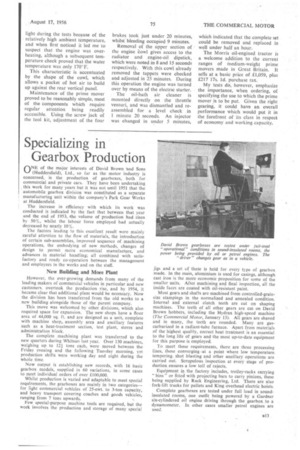Specializing in Gearbox Production
Page 47

If you've noticed an error in this article please click here to report it so we can fix it.
ONE of the major interests of David Brown 'and Sons (Huddersfield), Ltd., so far as the motor industry is concerned, is the production of gearboxes, both for commercial and private cars. They have been undertaking this work for many years but it was not until 1951 that the automobile gearbox division was constituted as a separate manufacturing unit within the company's Park Gear Works at Huddersfield.
The increase in efficiency with which its work was conducted is indicated by the fact that between that year and the end of 1953, the volume of production had risen by 50%, whilst the labour force employed had actually decreased by nearly 10%.
The factors leading to this excellent result were mainly careful attention to the flow of materials, the introduction of certain sub-assemblies, improved sequence of machining operations, the embodying of new methods, changes of design to permit more economical manufacture, and advances in material handling; all combined with satisfactory and ready co-operation between the management and employees in the works and on the staff.
New Building and More Plant
However, the ever-growing demands from many of the leading makers of commercial vehicles in particular and new customers, overtook the production rise, and by 1954, it became clear that additional plant would be necessary. Now the division has been transferred from the old works to a new building alongside those of the parent company.
This move was welcomed by other divisions, which also required space for expansion. The new shops have a floor area of 44,000 sq. ft. and are designed as a unit, complete with machine shop,, assembly area and ancillary features such as a heat-treatment section, test plant, stores and administration block.
The complete machining plant was transferred to the new quarters during Whitsun last year. Over 130 machines, weighing up to in tons each, were moved between the Friday evening and the following Tuesday morning, yet production shifts were working day and night during the whole time.
Now output is establishing new records, with 16 basic gearbox models, supplied in 60 variations, in some cases to meet individual orders of over £100,000.
Whilst production is varied and adaptable to meet special requirements, the gearboxes are mainly in two categories— for light commercial vehicles of 25-cwt. to 3-ton capacity, and heavy transport covering coaches and goods vehicles, ranging from 7 tons upwards.
Few special-purpose machine tools are required, but the work involves the production and storage of many special jigs and a set of thee is held for every type of gearbox made. In the main, aluminium is used for casings, although cast iron is the more economic proposition for some of the smaller units. After machining and final inspection, all the inside faces are coated with oil-resistant paint.
Most gears and shafts are machined from controlled-grainsize stampings in the normalized and annealed condition. Internal and external clutch teeth are cut on shaping machines. The teeth of all other gears are cut on David Brown hobbers, including the Hydrax high-speed machine (The Commercial Motor, January 13). All gears are shaved and in many, the teeth are rounded. Many are gascarburized in a radiant-tube furnace. Apart from materials of the highest quality, correct heat treatment is an essential to the long life of gears and the most up-to-date equipment for this purpose is employed.
To meet these requirements, there are three processing lines, these converging ,at a point where low temperature. tempering, shot blasting and other ancillary operations are carried out. Scrupulous inspection at every stage of production ensures a low toll of rejects,
Equipment in the factory includes, trolley-racks carrying "bins" or fitted with projecting bars to carry pinions, these being supplied by Rack Engineering, Ltd. There are also fork-lift trucks for pallets and King overhead electric hoists.
Complete gearboxes are tested under full load in soundinsulated rooms, one outfit being powered by a Gardner six-cylindered oil engine driving through the gearbox to a dynamometer. In other cases smaller petrol engines are user.1.




































































































